The typical wine tourist in our country is a woman traveling as a couple, between 36 and 45 years old, who travels by car and spends the night in the place she is visiting, contracts the stay on the Internet and spends more than two days at the chosen destination. These are the conclusions of the tenth Wine Tourism Demand Report.
Recently, ACEVIN – Spanish Association of Wine Cities has made public the report Analysis of the Spanish Wine Routes Tourism Demand 2018-2019through the Tourism Observatory of the Wine Routes of Spain. This study analyzes how wine tourists travel, as well as their profile and preferences.
According to the data collected in the report, the majority of wine tourists in Spain are women (52.3% compared to 47.7% of men) and the most represented age groups are those from 36 at age 45 (27.8%), those between 46 and 55 (26.4%) and those between 26 and 35 (21%). With regard to age, it is worth noting that the young audience band (18-25 years old) has experienced a growth of more than 2% compared to 2018.
The vast majority of wine tourists travel by car, either rented or owned (85.5%). In terms of lodging, the majority opt for hotels (41.9%) and rural lodgings (23%). Their average stay exceeds two days(2.4) and wine tourists travel as a couple (44%) or in groups of friends (29%). In addition, 60.48% of wine tourists spend the night at their destination.
The importance of digital media should also be highlighted, as 50.9% of wine tourists book their stay by email or other online means, compared to 29.2% who book by telephone. Almost 20% (19.9%) also recognize that they have learned about the wine route visited through the Internet and 21.8% through the winery’s website or social networks.
What activities do wine tourists do?
Although the average stay of visitors has dropped slightly (from 2.43 days in 2018 to 2.4 days), the activities they engage in are very diverse. The preferred option, as is logical, is the visit to the wineries, which 84.4% of visitors do.
In second place, and with a very significant growth compared to 2018, almost 15%, is the visit to nearby towns and villages. 63.5% of wine tourists opt for this option during their visits. Related to this, we found that the third most popular activity is enjoying the local gastronomy(56.5%) and the fourth is tasting local wines(52.3%). In addition, almost half of the wine tourists(48%) buy wine during their stays.
Other activities chosen by visitors are wine museums (27.3%), nature activities (25.8%), cultural activities(23.9%), visits to vineyards (17.5%), wine tourism events(10.7%) and wine tasting courses(8%).
As for the reasons that lead wine tourists to make visits, most of them come from a specific wine destination(40%), although 36.3% come to the Routes as part of their leisure or vacation trips. Other aspects that motivate the trip are the gastronomy of the area(5.7%), the culture of the wine regions(5.3%) and nature(3.3%).
Wine tourism spending has stabilized after several years of significant growth. The average daily expenditure is 160.2 euros and is still higher than that of the general foreign tourist (146 euros per day, according to the latest report of the INE-EGATURUR).
INE-EGATUR
) and that of national tourists (47.70 euros per day, according to data from
FAMILITUR
). The average total expenditure of wine tourists was 384.51 €, slightly lower than the previous year (393.38 €).
Satisfied wine tourists
The level of satisfaction among wine tourists is very high, reaching 8.56 points out of 10, a considerable increase from 8.30 points in 2016.
The most satisfactory aspects, above the rest, are the following visits to the wineries, with an average rating of 8.82 points, the hospitality in customer service (8.70 points), the stay in the accommodations (8.69 points), the quality of the surroundings(8.65 points), and the gastronomic offer(8.61).
Visits to wine museums (8.39 points), wine cellars (8.26), and tourist attention and information(8.24) also achieve good scores, while the worst rated aspects are tourist signage(7.58 points), and roads, trails and infrastructure(7.64).
In addition, an increasing number of visitors say they have visited a Wine Route before and decide to repeat the experience (58.3%, 2% more than in the previous period). The Wine Routes most popular among those surveyed are Rioja Alavesa (30.9%), Ribera del Duero (28.3%), Rioja Alta (26.1%) and Marco de Jerez (21.8%), followed by Penedès, Rías Baixas, Rueda and Somontano. With respect to those they wish to visit in the near future, interest is focused on Ribera del Duero (34.1%), Rías Baixas (30.5%), Rioja Alta (23.2%), Marco de Jerez (23.2%), Rioja Alavesa (22.9%) and El Bierzo (22.2%).
Of course, the three Familia Martínez Bujanda estates are included in the corresponding wine route.
Finca Valpiedra, to the Rioja Alta wine route, Finca Montepedroso to the Rueda wine route and Finca Antigua to the La Mancha wine route. We invite you to visit them.




